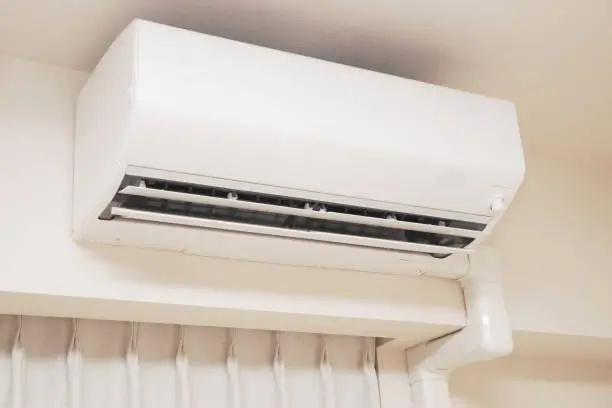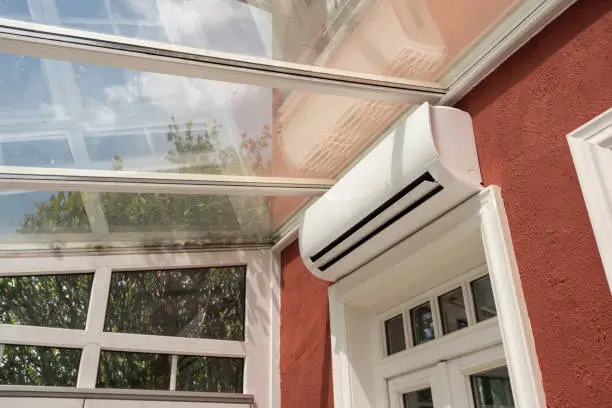Australian summers are getting hotter, making us look for better cooling options. Residential evaporative coolers are becoming a top choice. They use energy-efficient cooling solutions and are good for the environment.
These coolers work by cooling air through evaporation. This method not only cools but also cuts down on electricity use. They use less power than traditional air conditioners, saving you money.
Evaporative coolers work best in dry climates, which is common in Australia. If you’re thinking of getting one, check out Alpha Air for help. They offer resources for installing and keeping these coolers in top shape.
When deciding, think about what’s best for your home and local weather. Residential evaporative coolers might just be the perfect fit.
What Are Residential Evaporative Coolers?
Residential evaporative coolers, also known as swamp coolers or desert coolers, cool homes efficiently. They use water to lower air temperature. These units have a fan, water pump, and cooling pads to circulate cool air.
They have a long history, dating back to ancient times. People used water to cool the air then.
Understanding the Basics
Evaporative coolers are simple and efficient. They work best in dry places like Mildura, with humidity around 20-30%. They use less energy than traditional air conditioning, saving up to 80% on electricity.
The Science Behind Evaporative Cooling
Evaporative cooling works by cooling air through evaporation. Warm air passes through wet pads, cooling down. This method cools the air and adds moisture, helping in dry environments.
For more information, check out evaporative coolers online.
How Do Residential Evaporative Coolers Work?
Residential evaporative coolers work in a simple yet effective way. They pull in warm air from outside and pass it through wet pads. As the air goes through these pads, water evaporates, cooling it down naturally.
This cool air is then spread all over the house through ducts or vents. This makes the air fresh and healthier, unlike traditional air conditioners that just recirculate the same air.
Cooling Process Explained
The cooling process of evaporative coolers is especially good in dry, hot places. Since they need open windows or doors to work well, many Australians prefer them over traditional air conditioners. They bring in fresh outdoor air, which helps keep the house cool.
Also, these coolers use much less power than traditional air conditioners. This means they can save you money on your energy bills.
Comparative Analysis with Traditional Air Conditioning
Looking at evaporative coolers and traditional AC, each has its own benefits. Traditional air conditioners are great for cooling in humid places. But they recycle indoor air and use harmful substances, which is bad for the environment.
On the other hand, evaporative coolers don’t harm the environment. They’re better for the planet and can save you money. This makes them a smart choice for people living in dry areas where humidity is usually low.
Advantages of Residential Evaporative Coolers
Residential evaporative coolers offer many benefits for homeowners. They are effective and affordable for cooling homes. These systems are also very energy-efficient and have a low environmental impact.
Energy Efficiency Benefits
Evaporative coolers use much less power, needing only 200 to 400 watts. This can cut electricity bills by up to 75% compared to air conditioning. They cool well without using a lot of energy, thanks to their design.
Cost-Effective Cooling Solution
Buying an evaporative cooler is often cheaper upfront. This makes them great for those watching their budget. Even with ducting costs, they are still a cost-effective choice. They offer continuous cooling at a lower cost than traditional systems.
Eco-Friendly Cooling Option
Evaporative coolers are eco-friendly because they use water, not harmful refrigerants. This means they have a low carbon footprint. They are especially good for homes in warm, dry areas, improving air quality and helping the environment. For more on how they work, check out this guide.
Disadvantages of Residential Evaporative Coolers
Swamp coolers are eco-friendly and cost-effective. But, they have some downsides to think about. Their success depends a lot on the local weather. In humid places, they struggle with high moisture levels.
Limitations in Humid Environments
Evaporative coolers don’t work well in humid areas. They cool by evaporating water, but this doesn’t work when the air is already wet. This makes them less effective, leading people to look for other cooling options.
Dependence on Weather Conditions
The performance of evaporative coolers depends on the weather. They work best in hot, dry places like Melbourne. But, in extreme heat or high humidity, they don’t cool as well. They also need open windows for good airflow, which can be a problem during bad air days.
Costs Associated with Residential Evaporative Coolers
Homeowners need to know the costs of residential evaporative coolers. These costs include installation and operational costs. Operational costs cover electricity and water use.
Installation Costs Overview
Installation costs vary based on the system and ductwork needs. Standalone units start at $2,500. Total costs, including ducting, can reach $5,000. Hiring licensed pros ensures proper installation and efficiency.
Operational Costs: Electricity and Water Usage
Operational costs for ducted evaporative coolers are significant. Modern units use 200 to 400 watts. This leads to a cost of $0.14 to $0.35 per hour, based on size.
For 8 hours a day over 90 days, costs range from $97.20 to $251.10. Local rates and unit efficiency affect this. Water use is also important, with ducted units using hundreds of litres daily.
How to Choose the Right Evaporative Cooler for Your Home
Choosing evaporative coolers needs careful thought. The climate is key to picking the right one. They work best in hot, dry places like Mildura.
In humid areas, they might not cool as well. So, people might look for other cooling options.
Consider Your Climate
Knowing your local climate is crucial. Look at humidity and temperature to see if evaporative coolers fit your home. They can cool the air by up to 30 degrees Fahrenheit.
But they need hot air to work best. This hot air helps cool the air more efficiently.
Assessing Size and Capacity Needs
Choosing the right size evaporative cooler is important. You can figure out the CFM needed by following simple steps. For example, a room of 350 square feet with a 10-foot ceiling needs a 1750 CFM unit.
There are coolers for small rooms and whole houses. Picking the right size ensures good cooling without wasting energy.
Maintenance Tips for Your Evaporative Cooler
Keeping your evaporative cooler in top shape is key. Regular care boosts cooling power and extends its life. By following maintenance tips, you’ll save on energy and avoid expensive fixes.
Regular Cleaning and Upkeep
It’s vital to clean your evaporative cooler every year. Changing cooling pads and cleaning filters helps prevent blockages and improves airflow. Also, check the water quality to avoid mineral build-up.
Simple tasks like checking water levels and belt inspections can be done at home. But, getting a pro to service it twice a year is best. They know how to keep it running smoothly, saving you money on energy.
Water Management Systems
Managing water well is crucial for your evaporative cooler. Knowing how much water it uses helps. Good water management boosts cooling and follows local water rules.
Make sure the water pump works right and water drains properly to avoid leaks. By focusing on water management, you’ll save water and keep your cooler cool. This makes your evaporative cooler a smart choice for dry areas.
Residential Evaporative Coolers vs. Traditional Air Conditioners
Homeowners often choose between evaporative coolers and traditional air conditioners for cooling. It’s important to compare their efficiency. Evaporative coolers use less electricity and work well in dry places, cooling by 12-14˚C. But, they’re not as good in humid areas.
Traditional air conditioners cool better in humid weather. They’re more reliable in these conditions.
Comparative Efficiency and Effectiveness
Both cooling options work well, but differently. Evaporative coolers are best in dry climates. They save energy but don’t work well in humid places.
Traditional air conditioners perform well in all weather. They’re popular in Australia for this reason.
Cost Analysis Over Time
Initial costs for evaporative coolers start at $200, while air conditioners start at $300. Built-in systems cost between $3000 and $5000 to install. This depends on the type and labour needed.
Running costs also matter. Evaporative coolers cost $65-$85 a year. Air conditioners cost about $0.91 per hour. Evaporative coolers are cheaper in dry areas but not in humid ones.
Ideal Conditions for Using Residential Evaporative Coolers
To get the most out of residential evaporative coolers, knowing the best environments is key. These systems work best in dry, hot climates. In places like Victoria, South Australia, Tasmania, and parts of Western Australia, they shine.
Here, they cool effectively and make homes more comfortable without using too much energy.
Best Operating Environments
Evaporative coolers work best when humidity is 40% or less. At these levels, they cool well and can slightly increase indoor humidity. This small increase is usually not felt.
But, if humidity goes over 70%, they cool less well. In such cases, other cooling methods might be better.
Humidity and Temperature Considerations
The mix of humidity and temperature is crucial for evaporative coolers. They can still cool well when humidity is between 40% and 60%, with enough air flow. But, too much humidity, especially over 70%, makes them less effective.
In humid areas like Queensland and the Northern Territory, traditional air conditioning is a better choice.
Customer Experiences and Case Studies
Residential evaporative coolers are becoming popular in Australia. They are seen as a cost-effective and eco-friendly cooling option. Many customers have shared their positive experiences with these coolers.
They say these coolers keep their homes cool and comfortable while saving on energy bills. They work best in dry conditions, providing a cool escape from the heat. Plus, they improve indoor air quality.
Users love the natural cooling method. It only needs water and air, making it good for the environment.
Success Stories from Australian Homes
Many Australian families have chosen evaporative coolers. They share stories of saving money on energy and feeling more comfortable. These coolers use less energy than traditional air conditioners.
They help families save on bills and reduce their carbon footprint. In dry areas, they work well and add moisture to the air. This makes them a popular choice for eco-friendly cooling.
Common Challenges Faced by Users
While many enjoy their evaporative coolers, there are some challenges. Keeping them clean and checking water levels and cooling pads is important. Seasonal checks and draining hoses can extend their life.
Weather can affect how well the cooler works. In humid weather, it might not cool as much. This is something to think about when choosing a cooler.
Knowing these challenges helps potential buyers understand what’s needed to keep their cooler working well.
For more info on evaporative coolers, check out this resource.
Conclusion
In this article, we looked at why residential evaporative coolers are great for cooling homes in Australia. Places like Melbourne have very hot summers. These coolers are cheaper to install and maintain than traditional air conditioning.
They also use less electricity, which means lower bills and a smaller carbon footprint. This makes them a popular choice for those who want to save money and help the environment.
These systems use water, which is good for the planet. They keep the air fresh and clean. This is important in Australia’s dry climate where air can get stale quickly.
There are many models available, like Breezair, Braemar, and Coolair. They fit well into modern homes.
When choosing a cooler, think about the size of your rooms and how humid it is where you live. For help with installation and upkeep, companies like Alpha Air in Melbourne are there for you. So, if you’re looking for a cool, cost-effective, and green way to cool your home, evaporative coolers are a good option.







